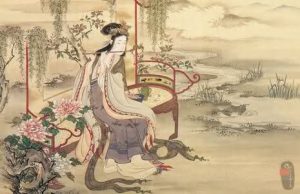Amy Tan’s The Valley of Amazement portrays a world where women navigate a society shaped by rigid hierarchies, cultural expectations, and unequal power structures. Set largely in the courtesan houses of early twentieth-century Shanghai, the novel examines how women interact with one another in circumstances that blend glamour with captivity, and opportunity with exploitation. These relationships are rarely simple: they are full of loyalty and betrayal, compassion and jealousy, mentorship and competition.
The central thread of the novel — the relationship between Violet and her mother, Lulu — provides the emotional foundation for exploring how female bonds shape identity, survival, and resilience. At the same time, Tan expands this exploration through the women who surround Violet: courtesans, servants, madams, and friends, all of whom influence her life with their own complicated motivations.
To illuminate these dynamics, it is useful to look closely at how Tan depicts women supporting each other, how rivalry emerges despite shared struggles, and how the mother–daughter relationship transforms across distance and trauma. These themes not only enrich the narrative but also highlight the broader cultural and historical backdrop against which the characters must navigate their limited autonomy.
Courtesan Houses as Sites of Both Solidarity and Competition
The world of the Shanghai courtesan house is central to Tan’s examination of female relationships. It is an environment built around performance, beauty, and social manipulation, yet it also functions as a rare communal space where women live and work together. In many ways, the courtesan house is a paradox: it is a place of both confinement and education, a site where women learn to control men while often lacking control over their own lives.
Among the courtesans, solidarity emerges naturally. They share the daily grind of entertaining clients, maintaining appearances, and following the strict behavioral codes enforced by the madams. Younger courtesans often depend on more experienced ones for guidance in etiquette, emotional management, and self-protection. Tan presents several moments when older courtesans quietly shield younger ones from abusive clients or teach them strategies for negotiating better terms.
Yet this solidarity coexists with constant competition. Courtesans vie for attention, wealth, and long-term patrons. Their social status depends on their desirability, which creates tension among women who might otherwise become close. Tan does not romanticize these relationships — she acknowledges the jealousy, the sabotage, the sharp awareness that one woman’s success may threaten another’s survival.
Despite this, the courtesan house remains one of the few spaces where women can shape their destinies through wit, talent, and emotional intelligence. Even when rivalry is present, there exists an understanding that all of them are working within a system designed to limit their autonomy. This shared struggle forms a foundation for empathy, even when daily circumstances make that empathy difficult to express.
Mothers, Daughters, and the Tension Between Protection and Freedom
The heart of the novel lies in the relationship between Lulu and Violet, a bond marked by love, misunderstanding, abandonment, and eventual reconciliation. Their story reflects a longstanding literary tradition in which mothers and daughters grapple with the tension between heritage and independence. Yet Tan frames this tension within the specific challenges faced by women who must navigate cultural barriers, economic constraints, and personal trauma.
Lulu’s choices — often misunderstood by Violet — are shaped by her desire to protect her daughter from the very world she herself lives in. When Violet is separated from her mother and forced into a courtesan house, she interprets the loss as rejection rather than a consequence of circumstances beyond Lulu’s control. This emotional wound shapes Violet’s relationships with other women for years, influencing whom she trusts, whom she resents, and how she defines her sense of belonging.
As Violet matures, she becomes entangled in her own roles as both a daughter and eventually a mother. Her interactions with other women — courtesans, mentors, friends — reveal how much she has internalized Lulu’s lessons, even when she rejects them on the surface. Tan masterfully portrays the cyclical nature of maternal influence: the values passed down, the mistakes repeated, the hopes that survive.
The eventual reunion between Lulu and Violet is one of the novel’s most powerful examples of female solidarity. Their reconciliation is not portrayed as sentimental or easy but as a hard-won recognition of one another’s humanity. Through this, Tan suggests that mother–daughter bonds are resilient even when fractured by trauma, distance, and silence.
Support and Rivalry Among Women: A Complex Tapestry
Beyond the immediate environment of courtesan houses and family ties, the novel includes numerous relationships that further develop the themes of solidarity and rivalry. Violet interacts with a wide range of women representing different social backgrounds — from mothers struggling to protect their children, to courtesans fighting for financial independence, to women refusing to yield to patriarchal expectations.
Tan illustrates how female solidarity often arises in moments of crisis. Women share resources when men fail them, offer emotional guidance, and teach one another strategies for survival. Some characters become unlikely allies, crossing cultural or class boundaries to help one another. These acts of quiet resilience demonstrate how women create informal networks of support even within oppressive systems.
At the same time, Tan refuses to portray solidarity as uncomplicated. Rivalry is woven into the social fabric of the courtesan world, where survival often depends on outperforming other women. Envy arises from unequal opportunities, favoritism, and the constant pressure to maintain beauty and youth. Betrayal occurs not because women are inherently antagonistic, but because the system pits them against one another.
Tan’s portrayal of these tensions mirrors real historical conditions for women in patriarchal societies. Her characters demonstrate that solidarity is not a simple moral choice but a complex negotiation shaped by survival, opportunity, and emotional vulnerability.
Table: Key Forms of Female Relationships in the Novel
| Type of Relationship | Core Characteristics | Their Role in Violet’s Story |
|---|---|---|
| Courtesan Solidarity | Emotional support, shared labor, guidance, protection | Helps Violet adapt to courtesan life and understand unspoken rules |
| Professional Rivalry | Competition for patrons, jealousy, status tensions | Reveals structural pressures that shape women’s behavior |
| Mother–Daughter Bonds | Love mixed with misunderstanding, sacrifice, trauma | Drives the emotional arc of the novel and Violet’s identity |
| Cross-Class Alliances | Unexpected friendships, mutual aid | Demonstrates how empathy emerges despite social divides |
Conclusion
In The Valley of Amazement, Amy Tan presents a complex and deeply human portrait of female relationships shaped by historical constraints and emotional resilience. The courtesan houses of Shanghai, with their blend of glamour and entrapment, serve as a powerful backdrop for examining how women form bonds of mentorship, rivalry, loyalty, and survival. These interactions reflect both the possibilities and the limits of solidarity in a world where women’s autonomy is constantly challenged.
Through Violet’s journey and the stories of the women who surround her, Tan emphasizes that female relationships are never one-dimensional. Solidarity coexists with competition; affection grows alongside resentment; independence emerges through shared hardship. The mother–daughter narrative between Lulu and Violet underscores how profoundly women influence one another across generations, even when separated by trauma or misunderstanding.
Ultimately, the novel argues that women’s connections — however fragile or conflicted — are essential sources of strength. They offer emotional grounding, practical support, and a sense of belonging in an often unstable world. Tan’s nuanced portrayal invites readers to reconsider conventional ideas about female rivalry and instead appreciate the resilience, adaptability, and profound depth of women’s relationships.


